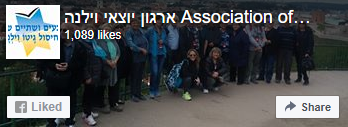Esther Yellin
 Esther Yellin was born in Kaunas, Lithuania in 1940 to the author Meir Yellin; ten months before the start of the occupation of the country by Nazi Germany.
Esther Yellin was born in Kaunas, Lithuania in 1940 to the author Meir Yellin; ten months before the start of the occupation of the country by Nazi Germany.
Her uncle Chaim Yellin was a leader of the AKO, an anti-fascist underground organization in the Kaunas ghetto. Both parents of Esther Yellin were also members and fighters of this organization.
The AKO tried, among other things, to save around 1,400 Jewish children who lived in distress and constant threat in the Kaunas ghetto. One of these children was Esther Yellin.
After all, her parents had the rare luck of finding real heroes who were willing and able to hide little Esther from the Nazis. During the first two months after escaping the ghetto, Esther Yellin was hidden in the home of Sofija Čiurlioniene Kymantaitė, her daughter Danutė Čiurlionytė, and her husband Vladys Zubovas. It was the family of the Lithuanian painter, composer and writer Mikalojus Konstantinas Čiurlionis (1875-1911).
After this time the Čiurlionis family and the bishop Matulonis helped to hide Esther Yellin in a convent in Čiobiškis and to bring her through safely until the end of the war.
Chaim Yellin was captured and murdered in 1944 when he was 31 years old. Esther Yellin's two parents, on the other hand, were very lucky to survive and eventually raise their daughter together.
An artistic education in the post-war Soviet Union was anything but easy to come by. For three years, Esther's mother, Dweira Yellin-Kormanaite - a pianist herself - taught her daughter classical piano art.
After these first three years, her parents let Yellin take lessons from Jakov Ginsburg; the brother of the then legendary pianist Grigori Ginsburg.
It quickly became apparent that this sensitive little girl was a real child prodigy:
At the age of 9, Esther Yellin gave her first concert with the Vilnius Radio Symphony Orchestra.
In 1956, when she was 15, Esther Yellin was discovered by Anaida Sumbatyan; one of the most renowned piano teachers at the Central Music School in Moscow. Among the most important students of Anaida Sumbatyan were Vladimir Ashkenazy , Vladimir Krainev and Oxana Yablonskaya . Esther Yellin left Lithuania as a teenager to take piano lessons in the Russian capital.
In 1958, Esther Yellin finally succeeded in becoming part of Heinrich Neuhaus' legendary master class . Heinrich Neuhaus was one of the most important piano teachers of the 20th century. Among other things, he taught Sviatoslav Richter , Emil Gilels and Radu Lupu .
Heinrich Neuhaus is also the author of The Art of Piano Playing , which is now considered a standard work.
The lessons with Heinrich Neuhaus were brilliant and ruthless at the same time. The artist's name or his achievements didn't matter. Just the music. Virtuosity was completely irrelevant if the artistic quality was poor. One of the most famous quotes from Neuhaus was:
“ You don't play the piano with your fingers, but with your heart and brain !”
After 6 years of study, Esther Yellin finally got her concert diploma thanks to Heinrich Neuhaus - and after his death in 1964 - with his son Stanislav Neuhaus. This gave her a job as a soloist at the Lithuanian Philharmonic.
In 1965, Esther Yellin took part in the Chopin Competition in Warsaw. As can be heard in unreleased recordings from this competition, their performances were unique. The winner of this year was Martha Argerich .
Unlike her famous colleagues, Esther Yellin never got the chance to give concerts in western countries. She never got permission to travel abroad. Performances and recordings were strictly controlled by Soviet authorities.
The positive aspect of this restrictive policy was that Yellin could concentrate exclusively on her artistic activity. There was no need to worry about funding, marketing, or managing her career. The number of concerts and locations were specified, organized and all administrative work was carried out by the authorities. In this way she was able to devote herself entirely to the artistic aspects of her work and become a well-known star in Lithuania and later also in Poland.
The loosening of Soviet politics in the early 1970s allowed Esther Yellin to emigrate to Israel in 1973; right at the time the Yom Kippur War broke out.
In Israel, she made friends with Menachem Meir, the son of Golda Meir , the then Prime Minister of Israel. Menachem Meir was a talented cellist and director of the Israel Music Conservatory in Tel-Aviv.
He was close friends with Esther Yellin until his death in 2014.
In Israel, Esther Yellin gave many concerts, filled the halls and was highly praised by the extremely critical Israeli press. For the first time she began to teach young pianists at the Israel Music Conservatory in Tel-Aviv.
When Esther Yellin finally moved to Switzerland in the early 1980s, she found herself in a world in which it was not enough to be an exceptional pianist. It took management for which it lacked meaning and opportunities.
She began to think about how she could inspire others with what she had learned from Heinrich Neuhaus. With the help of Swiss sponsors, she managed to found the Heinrich Neuhaus Sitftung in 1991 .
Many of her students became pianists, piano teachers, composers, philosophers and entrepreneurs and are now scattered almost all over the world. We students were not only inspired, but often challenged by the uncompromising depth and greatness of Esther Yellin's art.
From: Esther Yellin

